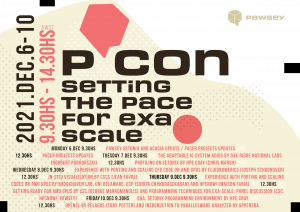

Pawsey Centre for Extreme Scale Readiness (PaCER)
About
The goal of PaCER is to prepare Australian computational researchers for the next era of supercomputing. The focus of the PaCER program is on both extreme scale research (algorithms design, code optimisation, application and workflow readiness) and using the computational infrastructure to facilitate research for producing world-class scientific outcomes.
PaCER provides researchers an opportunity to optimise their codes and workflows suitable for next-generation supercomputers. It is designed as a minimum 3-year partnership for collaboration with Pawsey and HPC vendors by providing early access to supercomputing tools and infrastructure, training and exclusive hackathons focused on HPC performance at scale.
Targeted PaCER Outcomes
PaCER projects will demonstrate:
- Significant performance improvement between existing Australian supercomputers and Pawsey’s next-generation supercomputer,
- Significant power efficiency improvement (performance per watt),
- Superior capability improvement for the whole scientific domain and ability to achieve previously unavailable computational, data processing and visualisation scales.
What PaCER is not
PaCER is not another allocation scheme.
PaCER is a partnership for collaboration between researchers and Pawsey Supercomputing Centre supercomputing specialists using the latest infrastructure provided by the PSS. It is built upon the recent, past experience of Pawsey and other supercomputing facilities, including Pawsey’s Petascale Pioneers and Athena Early Adopters programs, NERSC’s NESAP program, and ORNL’s CAAR. For more information: Powering the next generation of Australian research with HPE
New PaCER-led Positions
PaCER projects will have an opportunity to create new PhD or postdoctoral positions working on technical aspects of the project in relation to new advanced architectures. The new positions can be co-funded by PaCER. This co-investment model will serve as a tool to develop and grow competencies in supercomputing and computational sciences in Australia.
Pawsey’s Next-Gen Supercomputers
Supporting PaCER is the next-generation of Pawsey’s supercomputers.
Pawsey’s Supercomputing System (PSS) will replace Magnus and Galaxy through the Pawsey Capital Refresh project. The system will power future high-impact Australian research projects by delivering 30 times more compute power than predecessor systems Magnus and Galaxy.
Achieving sustainable scalability on the PSS will create a direct pathway to achieve superior scale on next-generation supercomputers. PaCER is Pawsey’s response to that unique opportunity.
PaCER Projects
The PaCER program was established in late 2020 to ready the research community to achieve extreme performance on Pawsey’s next-generation supercomputer Setonix. This long-term, $1.42 million partnership between researchers and Pawsey’s supercomputing specialists provides an opportunity for researchers to become exascale-ready, working on new algorithm designs and optimising codes, workflows and data movement pipelines.
Ten successful research projects were announced in March 2021. These research teams are gaining early access to supercomputing tools and infrastructure, training and exclusive hackathons focused on HPC performance at scale. Each three-year project is supported by a Pawsey co-funded doctoral or postdoctoral position and Pawsey expertise working closely with the research team.
| Project | Principal Investigator | Science Domain | Partners | Impact and Outcomes |
|---|---|---|---|---|
| EXESS: The EXtreme-scale Electronic Structure System, predicting the chemistry of nanomaterial interfaces | Dr Giuseppe Barca | quantum chemistry | ANU, Argonne National Laboratories, Ames National Laboratories, Monash University, Flinders University, Deakin University | Provide a framework to develop next-generation molecular modelling capabilities that support a broad spectrum of chemistry, biology, and material science research on computing systems ranging from petascale to exascale and beyond. Leveraging software development already underway in the US GAMESS Exascale Computing Project. |
| VISCOUS: Towards a molecular level understanding of flow-induced physical and chemical reactions | Professor Debra Bernhardt | statistical mechanics, rheology | University of Queensland | Develop codes for nonequilibrium molecular dynamics atop the extensively-used LAMMPS molecular dynamics software for performance at exascale. Simulate flow-induced chemical and physical reactions in liquids important to a wide range of industrial and biomedical applications including advanced materials manufacturing, nanoscale filtration and drug delivery technology. |
| MCCC: Calculation of collisions with molecular targets using the convergent close-coupling method | Professor Igor Bray | atomic and molecular physics | Curtin University | Produce high quality and comprehensive data describing the collision of electrons and positrons with molecules, which are needed in a range of applications. Exploit the capabilities of next-generation supercomputers, with a particular emphasis on accelerating calculations using GPU accelerators. Developments will allow the first-ever large-scale collision calculations to be performed for molecules more complex than H2. Resulting data sets will drastically improve plasma models in a wide range of scientific and industrial applications. |
| PIGI: Parallel interferometric GPU imaging | Professor Melanie Johnston-Hollitt | radio astronomy | Curtin University, University of Toronto | Develop new algorithms required to achieve science goals ranging from detecting the first stars and probing cosmic magnetic fields, to mapping the large-scale structures of our Universe. Combine the distributed nature of interferometric reconstruction algorithms with fast instrumental modelling using GPU accelerators, to accurately reconstruct images from extremely large data sets for future instruments such as the SKA. |
| EmPRiSM: Emergent phenomena revealed in subatomic matter | Dr Waseem Kamleh | nuclear physics | University of Adelaide | Develop novel algorithms for Lattice QCD calculations at extreme scale to unlock previously unachievable calculations of quantum fluctuations in the space–time vacuum. Explore how the foundation of matter evolves to regimes relevant to the interior of neutron stars and the early universe. |
| MaPMoPS: Massively parallel models of particle suspensions | Dr Christopher Leonardi | computational fluid dynamics, geoscience, petroleum | University of Queensland | Develop computational models of complex particle suspensions at previously intractable scales to investigate novel reservoir simulation techniques. Significantly improve the management of subsurface resources. Rearchitect in-house open source CFD code to leverage the next generation supercomputers. |
| HiVIS: Delivery of a next-generation data storage approach to unlock deep SKA and pathfinder observations | Dr Martin Meyer | radio astronomy, cosmology | ICRAR, University of Western Australia, CSIRO, SKA, Oak Ridge National Laboratories, Australian SKA Regional Centre | Address one of the most significant grand challenge problems for the SKA – how to optimally image multi-day deep data sets. Aim to reduce the visibility storage requirements for these projects by an order of magnitude by developing a sparse data storage and processing pipeline based on UV-grids. Enable ground-breaking new studies of the role atomic hydrogen has played in the ongoing evolution of galaxies and its connection to their dark matter halos. |
| GTx: Towards exascale simulations for efficient, low-emissions gas turbines | Professor Richard Sandberg, Professor Evatt Hawkes | computational fluid dynamics, turbulence, engineering | University of Melbourne, University of New South Wales, General Electric Global Research | Upscaling in-house codes for high-fidelity CFD simulations of components of gas turbines at engine-relevant conditions on next-generation supercomputers, and beyond. Investigate phenomena contributing to energy efficiency, pollutant emissions, and operability to improve predictive tools used in industry.
|
| EXA-GAMBIT: Searching for new particles from the attoscale to the exascale with GAMBIT | Professor Martin White | particle physics | University of Queensland, Monash University, University of Adelaide | Model new particles towards explaining the identity of dark matter and dark energy, why neutrinos have mass, why the Higgs boson is as light as it is, and why we are surrounded by so much more matter than antimatter. Make it possible to combine the results of all relevant experiments and bring them to bear on all of the leading theories for new particles, by using exascale computing hardware to simulate billions of possible experimental signatures simultaneously. |
| BLINK and you’ll miss it: blazingly-fast all-sky radio astronomy pipelines | Dr Marcin Sokolowski | radio astronomy | ICRAR, Curtin University, Australian SKA Regional Centre | Combine the data processing technology offered by next-generation supercomputers and novel data processing algorithms that have been optimised for both speed and sensitivity to transient signals. Enable real-time image-based transient searches (pulsars, gamma ray bursts and fast radio bursts). This will allow MWA and SKA-low to detect fast radio transients like spontaneously emitting neutron stars in real time. |
P’Con 2022
PaCER Conference – P’Con 2022 will take place in Perth, 5-7 October 2022.
Venue: Pawsey Supercomputing Research Centre, 1 Bryce Avenue, Kensington 6151 WA
Local Organising Committee (LOC): Ann Backhaus, Stacy Tyson, Karina Nunez, Aditi Subramanya, Maciej Cytowski
COVID Safe Plan: https://www.csiro.au/en/about/locations/COVID-Safe-Plan
Draft agenda is available here.
P’Con 2021
PaCER Conference – P’con: Setting the pace for exascale took place between 6-10 December 2021.

Selected talks from P’Con 2022 are available on Pawsey Supercomputing Research Centre YouTube channel.
PaCER Seminar Series
More about PaCER
- PACER – upscaling Australian researchers in the new era of supercomputing
- Extreme-scale readiness program doubles its impact
- PaCER, changing the science and research landscape
- Pawsey’s Capital Refresh Podcast, Episode 7: PACER, accelerating researchers in the new era of supercomputing
Documents
Please note that application to PaCER program is closed. The below documents are for reference purposes only.
- PACER_Information_for_Applicants, including assessment criteria, application process and eligibility rules,
- Submissions forms in two editable formats: MS Word and LaTeX